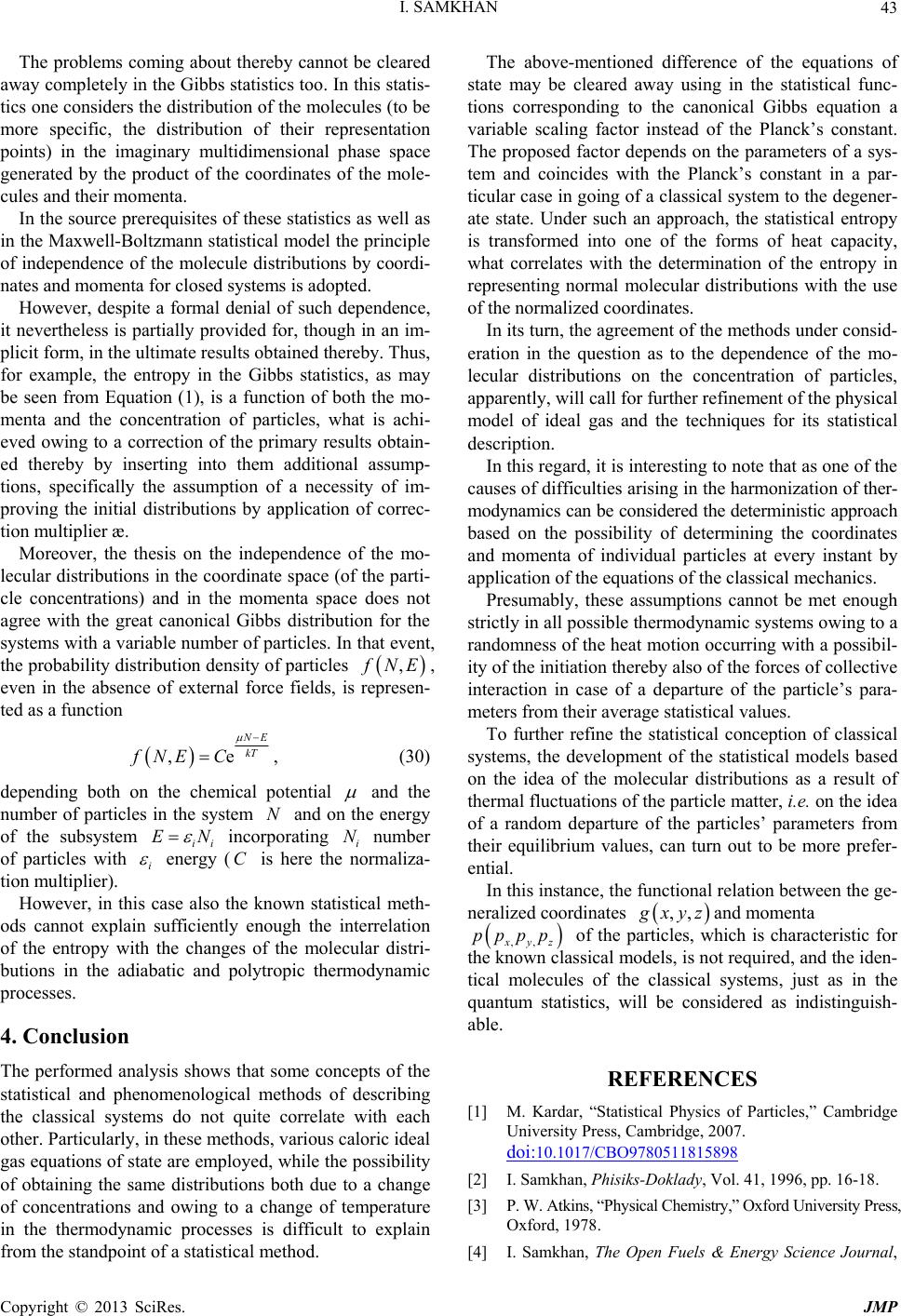
I. SAMKHAN 43
The problems coming about thereby cannot be cleared
away completely in the Gibbs statistics too. In this statis-
tics one considers the distribution of the molecules (to be
more specific, the distribution of their representation
points) in the imaginary multidimensional phase space
generated by the product of the coordinates of the mole-
cules and their momenta.
In the source prerequisites of these statistics as well as
in the Maxwell-Boltzmann statistical model the principle
of independence of the molecule distributions by coordi-
nates and momenta for closed systems is adopted.
However, despite a formal denial of such dependence,
it nevertheless is partially provided for, though in an im-
plicit form, in the ultimate results obtained thereby. Thus,
for example, the entropy in the Gibbs statistics, as may
be seen from Equation (1), is a function of both the mo-
menta and the concentration of particles, what is achi-
eved owing to a correction of the primary results obtain-
ed thereby by inserting into them additional assump-
tions, specifically the assumption of a necessity of im-
proving the initial distributions by application of correc-
tion multiplier æ.
Moreover, the thesis on the independence of the mo-
lecular distributions in the coordinate space (of the parti-
cle concentrations) and in the momenta space does not
agree with the great canonical Gibbs distribution for the
systems with a variable number of particles. In that event,
the probability distribution density of particles
,
NE ,
even in the absence of external force fields, is represen-
ted as a function
,e
E
kT
EС
fN, (30)
depending both on the chemical potential
and the
number of particles in the system and on the energy
of the subsystem ii
N
NE
incorporating i number
of particles with N
i
energy (C is here the normaliza-
tion multiplier).
However, in this case also the known statistical meth-
ods cannot explain sufficiently enough the interrelation
of the entropy with the changes of the molecular distri-
butions in the adiabatic and polytropic thermodynamic
processes.
4. Conclusion
The performed analysis shows that some concepts of the
statistical and phenomenological methods of describing
the classical systems do not quite correlate with each
other. Particularly, in these methods, various caloric ideal
gas equations of state are employed, while the possibility
of obtaining the same distributions both due to a change
of concentrations and owing to a change of temperature
in the thermodynamic processes is difficult to explain
from the standpoint of a statistical method.
The above-mentioned difference of the equations of
state may be cleared away using in the statistical func-
tions corresponding to the canonical Gibbs equation a
variable scaling factor instead of the Planck’s constant.
The proposed factor depends on the parameters of a sys-
tem and coincides with the Planck’s constant in a par-
ticular case in going of a classical system to the degener-
ate state. Under such an approach, the statistical entropy
is transformed into one of the forms of heat capacity,
what correlates with the determination of the entropy in
representing normal molecular distributions with the use
of the normalized coordinates.
In its turn, the agreement of the methods under consid-
eration in the question as to the dependence of the mo-
lecular distributions on the concentration of particles,
apparently, will call for further refinement of the physical
model of ideal gas and the techniques for its statistical
description.
In this regard, it is interesting to note that as one of the
causes of difficulties arising in the harmonization of ther-
modynamics can be considered the deterministic approach
based on the possibility of determining the coordinates
and momenta of individual particles at every instant by
application of the equations of the classical mechanics.
Presumably, these assumptions cannot be met enough
strictly in all possible thermodynamic systems owing to a
randomness of the heat motion occurring with a possibil-
ity of the initiation thereby also of the forces of collective
interaction in case of a departure of the particle’s para-
meters from their average statistical values.
To further refine the statistical conception of classical
systems, the development of the statistical models based
on the idea of the molecular distributions as a result of
thermal fluctuations of the particle matter, i.e. on the id ea
of a random departure of the particles’ parameters from
their equilibrium values, can turn out to be more prefer-
ential.
In this instance, the functional relation between the ge-
neralized coordinates
,,xyz and momenta
,,
yz
ppp of the particles, which is characteristic for
the known classical models, is not required, and the iden-
tical molecules of the classical systems, just as in the
quantum statistics, will be considered as indistinguish-
able.
REFERENCES
[1] M. Kardar, “Statistical Physics of Particles,” Cambridge
University Press, Cambridge, 2007.
doi:10.1017/CBO9780511815898
[2] I. Samkhan, Phisiks-Doklady, Vol. 41, 1996, pp. 16-18.
[3] P. W. Atki ns, “P hys i cal Ch emis try,” Oxfo rd Un iv ers it y P ress,
Oxford, 1978.
[4] I. Samkhan, The Open Fuels & Energy Science Journal,
Copyright © 2013 SciRes. JMP